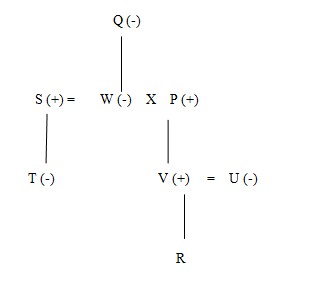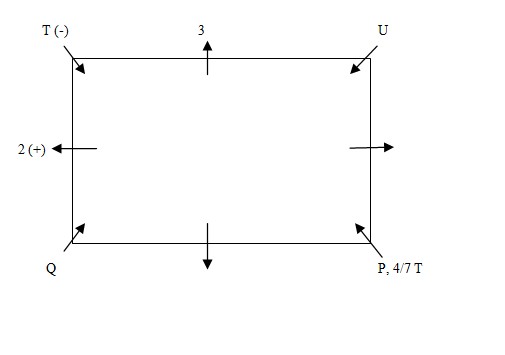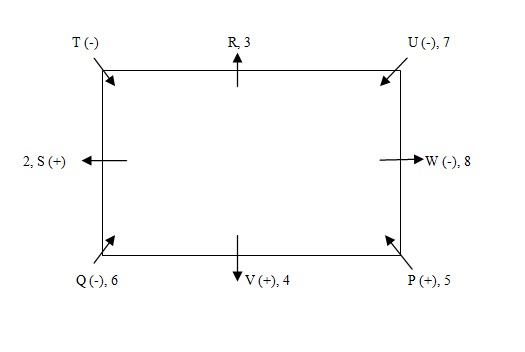Question
How many coins does W have?
Read the following information carefully and answer the questions given below it: P, Q, R, S, T, U, V and W are sitting around a square table in such a way that four of them who sits at the corner are facing towards the centre and other four who sits in the middle of the table are facing outside the centre. Each person has different number of coins viz. 1, 2, 3, 4, 5, 6, 7 and 8, but not necessarily in the same order. Only one person sits between W and V. V sits second to the right of the person who has 8 coins. W’s brother S, sits on the immediate left of his mother who has 6 coin. P is the father of V and only one person sits between W’s mother and T. S’s daughter sits second to the right of U and on the immediate left of that person who has 3 coins. Q sits second to the left of W’s husband who has neither 4 nor 7 coins. U, who is sister of V, has 7 coins and is not an immediate neighbour of W’s husband. T sits on the immediate right of the person who has 2 coins. S’s daughter has 1 coin. Only one person is sitting between P and U. No female is an immediate neighbour of Q, who sits at the corner of the table. V is father of R and is not an immediate neighbour of T. P is married to W.Solution
W’s brother S, sits on the immediate left of his mother who has 6 coins. P is the father of V and only one person sits between W’s mother and T. U, who is sister of V, has 7 coins and is not an immediate neighbour of W’s husband. V is father of R and is not an immediate neighbour of T. P is married to W. By the statement ‘only one person sits between W’s mother and T’, we find that Q is W’s mother and T is S’ daughter.  No female is an immediate neighbour of Q, who sits at the corner of the table. Q sits second to the left of W’s husband who has neither 4 nor 7 coins. Only one person is sitting between P and U. S’s daughter sits second to the right of U and on the immediate left of that person who has 3 coins. T sits on the immediate right of the person who has 2 coins.
No female is an immediate neighbour of Q, who sits at the corner of the table. Q sits second to the left of W’s husband who has neither 4 nor 7 coins. Only one person is sitting between P and U. S’s daughter sits second to the right of U and on the immediate left of that person who has 3 coins. T sits on the immediate right of the person who has 2 coins.  S, sits on the immediate left of his mother who has 6 coins. V is not an immediate neighbour of T. So, V can sit at immediate right or immediate left to P. If V sits immediate right to P, and as we know that W is female so she sit at immediate left to T. We know that V sits second to the right of the person who has 8 coins. By this statement this condition is not possible. If V sits immediate left to P, so W will sit at immediate right to P. Then R will sit at immediate left to T. Further V sits second to the right of the person who has 8 coins. It is given that T has 1 coin and that of U is 7. So V will have 4 and P will have 5 coins
S, sits on the immediate left of his mother who has 6 coins. V is not an immediate neighbour of T. So, V can sit at immediate right or immediate left to P. If V sits immediate right to P, and as we know that W is female so she sit at immediate left to T. We know that V sits second to the right of the person who has 8 coins. By this statement this condition is not possible. If V sits immediate left to P, so W will sit at immediate right to P. Then R will sit at immediate left to T. Further V sits second to the right of the person who has 8 coins. It is given that T has 1 coin and that of U is 7. So V will have 4 and P will have 5 coins 
In a certain code language, SHIRT is coded as RGGSU and HOUSE is coded as GNSTF. In the same code language, how will PRINT be coded as?
Select the option that represents the letters that, when sequentially placed from left to right in the blanks below, will complete the letter series.
How many letters are there in the given series which are immediately followed by a number?
L 6 7 Z @ U 5 % 6 L M @ N P L 9 @ Y # 5 F 6
There are five student Z, V, T, J and H scored different marks. Z scores more than J but less than V. T scores less than V but more than H, who score mo...
Select the option in which the numbers are related in the same way as are the numbers in the given set.
Given set: (175, 182, 203)
How many symbols are immediately preceded by a number less than 6 in the given arrangement?
Select the combination of numbers that when placed sequentially in the blanks of the given series will complete the series.
q r _ t _ v w _ r _ t...
After going 80 m from his home towards east, a person turns left and goes 20 m, then turns right and moves 100 m, then turns left and goes 60 m, then tu...
What is object of UPS?
Arrange the words in the alphabetical order and pick the one that come at second last.


